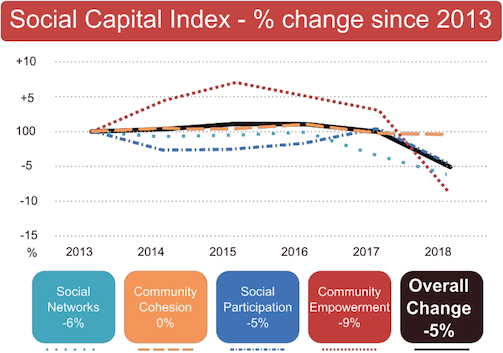Social capital in Scotland: report
Report examining social connections within Scottish communities and what can be done to make these communities stronger and more inclusive.
4. How strong is social capital in Scotland and how is it changing over time?
The Scottish Household Survey is an annual, nationally representative survey of Scotland that provides a means of looking at levels of social capital at a national level, across different dimensions.[9]
Several questions (Fig 12) associated with social capital themes have been included in the survey to track change over time.[10] Some of the questions have been asked each year since 2013 and provide a measure of change, and some of them are new (reported for the first time in 2019), and will provide trend data in the future.
Fig 12. Four social capital themes, and 18 questions
Social Capital Themes and questions
1. Social networks
- Could you rely on a neighbour for help?
- Would neighbours keep an eye on your home?
- Could you turn to neighbours for advice?
- Would you help your neighbours?
- Do you meet socially at least once a week?
- Have you felt lonely in the last week?
2. Community cohesion
- How good is your neighbourhood?
- Do you feel you belong to your neighbourhood?
- Do you feel safer in your neighbourhood?
- Can people be trusted in your neighbourhood?
- Are people kind to each other in your neighbourhood?
- Do people from different backgrounds get on well together?
- Are there places to meet and socialise?
- Are there welcoming places to meet new people?
3. Social participation
- Do you volunteer formally?
- Do you volunteer informally?
4. Community empowerment
- Can you influence local decisions?
- Do people improve the neighbourhood?
Levels of social capital
The latest data from the Scottish Household Survey (2018) shows strong evidence of positive social connections in communities in Scotland (Fig 13). Ninety-five percent of respondents rate their neighbourhood as ‘good’ or ‘very good’, 91% of people say they would help their neighbours, 83% of people say people are kind to each other in their neighbourhood and 48% are involved in informal or formal volunteering.
There is also some evidence that is not as positive. The survey shows that over 1 in 5 people in Scotland (21%), said they experienced loneliness ‘in the last week’. Twenty percent of people agreed that they have influence over local decisions. This means that a large proportion of people in Scotland (4 out of 5 people) do not feel that they can influence decisions about their area.
Fig 13. Levels of social capital by the most recent available measures.
Social Networks 2018
Percentages of people who agreed with statements:
- Could rely on neighbour to help 86%
- Neighbours would keep an eye on home 85%
- Could turn to neighbours for advice 77%
- Would help neighbours 91%
- Meets socially at least once a week 73%
- Could rely on neighbour to help 21%
Social participation 2018
Percentages of people who volunteered in the last 12 months:
- Formal volunteering 26%
- Informal volunteering 36%
- Formal and/or informal volunteering 48%
Community cohesion 2018
Percentages of people who agreed with statements:
- Positive neighbourhood rating 95%
- Neighbourhood belonging 78%
- Neighbourhood safety (2017) 82%
- Neighbourhood trust 78%
- Neighbourhood kindness 83%
- Places to meet and socialise 59%
- Welcoming places to meet new people 53%
- Diverse people get on well together 70%
Community empowerment 2018
Percentages of people who agreed:
- They can influence local decisions about their area 20%
- People take action to improve the local neighbourhood 58%
Changes over time
To show changes in social capital over time, these survey questions have been monitored annually from a base year of 2013, and aggregated into a ‘data index’, that tracks changes in levels.[11]
Values were set at ‘100’ in 2013 and the index shows the percentage change for subsequent years relative to the 2013 position. The trends in each of the variables have been monitored as well as the aggregated four themes (based on an equal weighting of the variables) and an overall trend (based on an equal weighting of the four themes).[12] More detailed information about the method for calculating the index is provided in Annex A.
The index (Fig 14) shows that after a period of relative stability in the four themes, by 2018 there had been an overall decrease of 5 percent in the overall measure of social capital compared to 2013. This has mainly been driven by reductions in the community empowerment theme (a smaller proportion of people say they feel they have influence over local decisions), the social networks theme (where fewer people agreed that they would provide or expect to receive help from neighbours), and the social participation theme (there has been a small reduction in the proportion of people who have taken part in volunteering).
Fig 14. Trends in social capital across 4 domains.

Contact
Email: ben.cavanagh@gov.scot
There is a problem
Thanks for your feedback